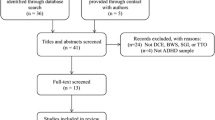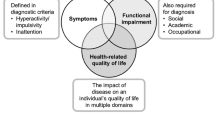Abstract
This study used standard gamble (SG) utility interviews to assess parent preferences for health states of childhood attention-deficit/hyperactivity disorder (ADHD). Health state utilities are needed to calculate quality-adjusted life years (QALYs), a critical outcome measure in cost-effectiveness studies of new treatments. Parents (n=43) of children diagnosed with ADHD completed SG utility interviews, rating their child’s current health and 11 hypothetical health states describing untreated ADHD and ADHD treated with a stimulant or non-stimulant. Parents completed questionnaires on their children’s symptoms and health-related quality of life (HRQL). Parents’ SG rating of their child’s current health state (mean of 0.74 on a utility scale ranging from 0 to 1) was significantly correlated with inattentive, hyperactive, and overall ADHD symptoms (r=0.37, 0.36, and 0.40 respectively; p < 0.05) and psychosocial HRQL domains. Hypothetical health state utilities ranged from 0.48 (severe untreated ADHD) to 0.88 (effective and tolerable non-stimulant treatment). Comparisons between health states found expected differences between untreated mild, moderate, and severe ADHD health states. When both treatments were effective and tolerable, parents preferred the non-stimulant health state over the stimulant health state (p < 0.03). Results suggest that parent SG interviews are a feasible and useful method for obtaining utility scores that can be used in cost-effectiveness models of ADHD treatment.
Similar content being viewed by others
References
InstitutionalAuthorNameAmerican Psychiatric Association. (2000) Diagnostic and Statistical Manual of Mental Disorders. EditionNumber4 American Psychiatric Press Washington, DC
RA Barkley (1998) Attention-Deficit Hyperactivity Disorder: A Handbook for Diagnosis and Treatment. Guilford Press New York
RA Barkley GJ DuPaul MB McMurray (1990) ArticleTitleComprehensive evaluation of attention deficit disorder with and without hyperactivity as defined by research criteria. J Consult Clin Psychol 58 IssueID6 775–789
RA Barkley AD Anastopoulos DC Guevremont et al. (1991) ArticleTitleAdolescents with ADHD: Patterns of behavioral adjustment, academic functioning, and treatment utilization. J Am Acad Child Adolesc Psychiatry 30 IssueID5 752–761
RD Hinshaw SM Melnick (1995) ArticleTitlePeer relationship in boys with attention deficit hyperactivity disorder with and without comorbid aggression. Dev Psychopathol 7 627–647
MG Sawyer L Whaites JM Rey et al. (2002) ArticleTitleHealth-related quality of life of children and adolescents with mental disorders. J Am Acad Child Adolesc Psychiatry 41 IssueID5 530–537
GW Torrance (1986) ArticleTitleMeasurement of health state utilities for economic appraisal. J Health Econ 5 IssueID1 1–30
GW Torrance (1996) Designing and conducting cost-utility analyses. B Spilker (Eds) Quality of Life and Pharmacoeconomics in Clinical Trials. EditionNumber2 Lippincott-Raven Publishers Philadelphia, PA
D Feeny RD Barr W Furlong et al. (1991) Quality of life of the treatment process in pediatric oncology: An approach to measurement. D Osaba (Eds) Effect of Cancer on Quality of Life. CRC Press Boca Raton, FL
GW Torrance W Furlong D Feeny (2002) ArticleTitleHealth utility estimation. Expert Rev Pharmacoeconomics Res 2 IssueID2 99–108
NK Leidy DA Revicki B Geneste (1999) ArticleTitleRecommendations for evaluating the validity of quality of life claims for labeling and promotion. Value Health 2 IssueID2 113–127
DL Patrick YP Chiang (2000) ArticleTitleMeasurement of health outcomes in treatment effectiveness evaluations: Conceptual and methodological challenges. Med Care Sep 38 IssueIDSuppl. 9 II14–25
EB Bass EP Steinberg HA Pitt et al. (1994) ArticleTitleComparison of the rating scale and the standard gamble in measuring patient preferences for outcomes of gallstone disease. Med Decis Making 14 IssueID4 307–314
J Cook J Richardson A Street (1994) ArticleTitleA cost utility analysis of treatment options for gallstone disease: Methodological issues and results. Health Econ 3 IssueID3 157–168
DH Feeny GW Torrance (1989) ArticleTitleIncorporating utility-based quality-of-life assessment measures in clinical trials. Two examples. Med Care Mar 27 IssueIDSuppl. 3 S190–S204
K Johnston J Brown K Gerard et al. (1998) ArticleTitleValuing temporary and chronic health states associated with breast screening. Soc Sci Med 47 IssueID2 213–222
DA Revicki M Wood (1998) ArticleTitlePatient-assigned health state utilities for depression-related outcomes: Differences by depression severity and antidepressant medications. J Affect Disord 48 IssueID1 25–36
A Gafni (1994) ArticleTitleThe standard gamble method: What is being measured and how it is interpreted. Health Serv Res 29 IssueID2 207–224
GW Torrance D Feeny (1989) ArticleTitleUtilities and quality-adjusted life years. Int J Technol Assess Health Care 5 IssueID4 559–575 Occurrence Handle1:STN:280:By%2BB3snmtFA%3D Occurrence Handle2634630
A Gilmore R Milne (2001) ArticleTitleMethylphenidate in children with hyperactivity: Review and cost-utility analysis. Pharmacoepidemiol Drug Saf 10 IssueID2 85–94
GJ DuPaul RA Barkley DF Connor (1998) Stimulants. RA Barkley (Eds) Attention-Deficit Hyperactivity Disorder: A Handbook for Diagnosis and Treatment. EditionNumber2 Guilford Press New York
T Spencer J Biederman T Wilens et al. (1996) ArticleTitlePharmacotherapy of attention-deficit hyperactivity disorder across the life cycle. J Am Acad Child Adolesc Psychiatry 35 IssueID4 409–432 Occurrence Handle10.1097/00004583-199604000-00008 Occurrence Handle1:STN:280:ByiD2sjhtlM%3D Occurrence Handle8919704
JM Zito DJ Safer S DosReis et al. (2003) ArticleTitlePsychotropic practice patterns for youth: A 10-year perspective. Arch Pediatr Adolesc Med 157 IssueID1 17–25
D Michelson D Faries J Wernicke (2001) ArticleTitleAtomoxetine in the treatment of children and adolescents with attention-deficit/hyperactivity disorder: A randomized, placebo-controlled, dose-response study. Pediatrics 108 IssueID5 E83 Occurrence Handle11694667
CJ Kratochvil JH Heiligenstein R Dittmann et al. (2002) ArticleTitleAtomoxetine and methylphenidate treatment in children with ADHD: A prospective, randomized, open-label trial. J Am Acad Child Adolesc Psychiatry 41 IssueID7 776–784
D Michelson AJ Allen J Busner et al. (2002) ArticleTitleOnce-daily atomoxetine treatment for children and adolescents with attention deficit hyperactivity disorder: A randomized, placebo-controlled study. Am J Psychiatry 159 IssueID11 1896–1901 Occurrence Handle10.1176/appi.ajp.159.11.1896 Occurrence Handle12411225
Sutton V, Sumner C, Allen AJ, et al. Validity, Reliability and Responsiveness of the DPREMB-R Scale for ADHD. Presentation at the meeting of the American Academy of Child and Adolescent Psychiatry; October, 2003; Miami, FL.
JM Landgraf M Rich L Rappaport (2002) ArticleTitleMeasuring quality of life in children with attention-deficit/hyperactivity disorder and their families: Development and evaluation of a new tool. Arch Pediatr Adolesc Med 156 IssueID4 384–391
GJ DuPaul TJ Power AD Anastopoulos et al. (1998) ADHD Rating Scale-IV: Checklists, Norms, and Clinical Interpretations. Guilford Press New York
C Kadesjo B Kadesjo B Hagglof et al. (2001) ArticleTitleADHD in Swedish 3- to 7-year-old children. J Am Acad Child Adolesc Psychiat 40 IssueID9 1021–1028
P Magnusson J Smari H Gretarsdottir et al. (1999) ArticleTitleAttention-deficit/hyperactivity symptoms in Icelandic schoolchildren: Assessment with the attention deficit/hyperactivity rating Scale-IV. Scand J Psychol 40 IssueID4 301–306
JM Landgraf LN Abetz JE Ware (1999) The CHQ User’s Manual. HealthAct Boston
L Asmussen LM Olson EN Grant et al. (2000) ArticleTitleUse of the child health questionnaire in a sample of moderate and low-income inner-city children with asthma. Am J Respir Crit Care Med 162 IssueID4 Pt 1 1215–1221
JM Landgraf E Maunsell KN Speechley et al. (1998) ArticleTitleCanadian-French, German, and UK versions of the Child Health Questionnaire: Methodology and preliminary item scaling results. Qual Life Res 7 IssueID5 433–445
M Wake K Hesketh F Cameron (2000) ArticleTitleThe Child Health Questionnaire in children with diabetes: Cross-sectional survey of parent and adolescent-reported functional health status. Diabet Med Oct 17 IssueID10 700–707
E Waters L Salmon M Wake (2000) ArticleTitleThe parent-form Child Health Questionnaire in Australia: Comparison of reliability, validity, structure, and norms. J Pediatr Psychol 25 IssueID6 381–391
E Waters L Salmon M Wake et al. (2000) ArticleTitleThe Child Health Questionnaire in Australia: Reliability, validity and population means. Aust NZ J Public Health 24 IssueID2 207–210
J Cohen (1988) Statistical Power Analysis for the Behavioral Sciences. EditionNumber2 Lawrence Erlbaum Associates Hillsdale, NJ
HI Brunner D Maker B Grundland et al. (2003) ArticleTitlePreference-based measurement of health-related quality of life (HRQL) in children with chronic musculoskeletal dis- orders (MSKDs). Med Decis Making 23 IssueID4 314–322
S Saigal PL Rosenbaum D Feeny et al. (2000) ArticleTitleParental perspectives of the health status and health-related quality of life of teen-aged children who were extremely low birth weight and term controls. Pediatrics 105 IssueID3 Pt 1 569–574
S Saigal BL Stoskopf E Burrows et al. (2003) ArticleTitleStability of maternal preferences for pediatric health states in the perinatal period and 1 year later. Arch Pediatr Adolesc Med 157 IssueID3 261–269
Author information
Authors and Affiliations
Corresponding author
Rights and permissions
About this article
Cite this article
Matza, L.S., Secnik, K., Rentz, A.M. et al. Assessment of health state utilities for attention-deficit/hyperactivity disorder in children using parent proxy report. Qual Life Res 14, 735–747 (2005). https://doi.org/10.1007/PL00022070
Accepted:
Issue Date:
DOI: https://doi.org/10.1007/PL00022070




